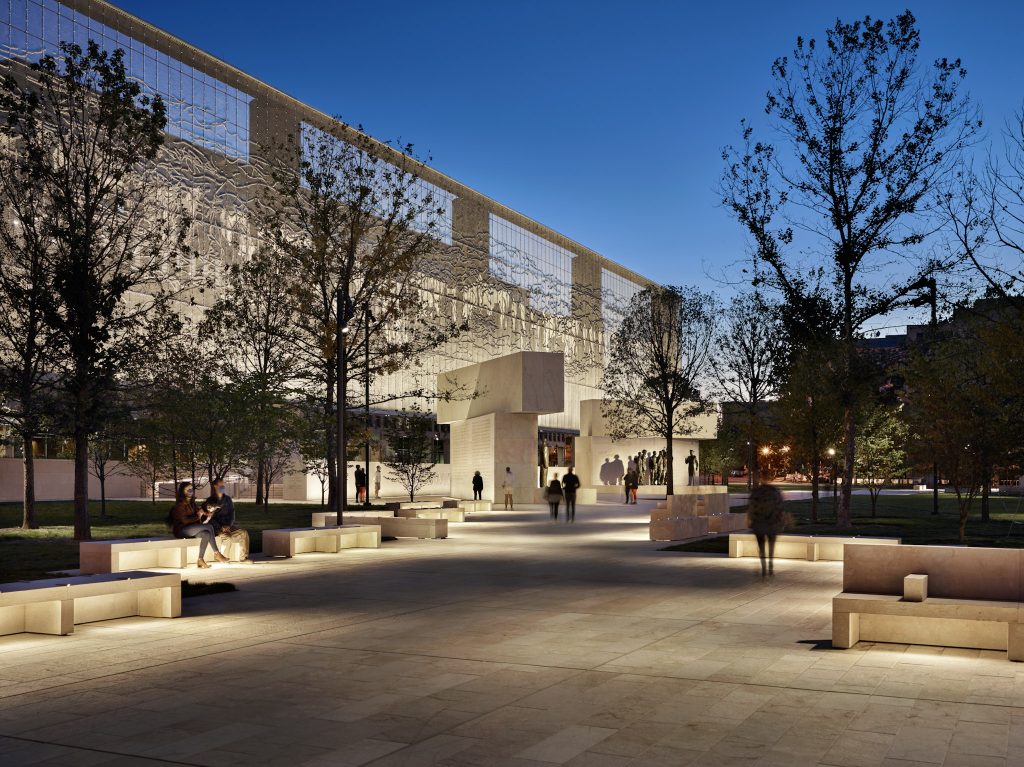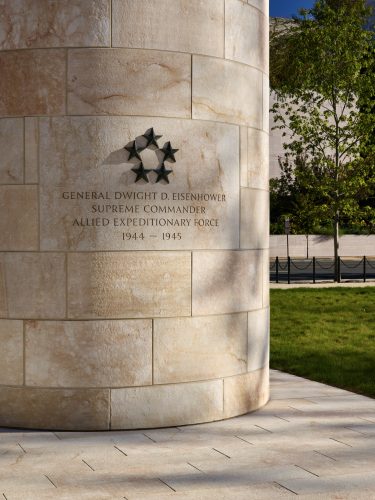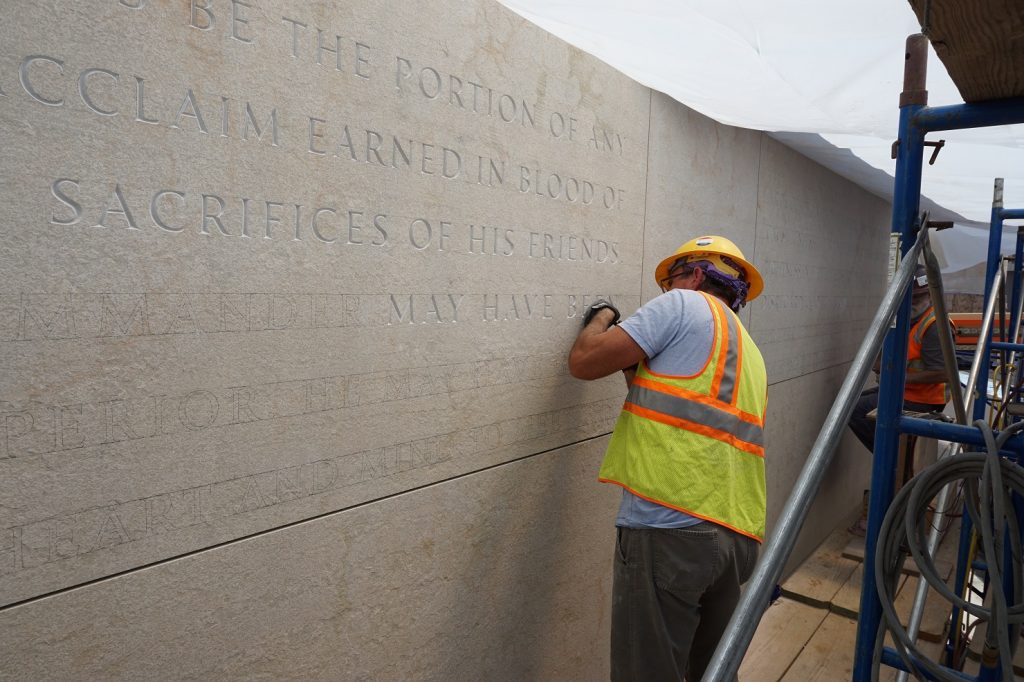Stone Consultant Helps Bring Presidential Memorial to Life

Courtesy of the Dwight D. Eisenhower Memorial Commission: Photography by Alan Karchmer; Memorial design by Gehry Partners, LLP; Tapestry by Tomas Osinski; Sculpture by Sergey Eylanbekov
When an architectural team wants to make sure the natural stone being specified for a project is available, the team calls Enzo Giambattista, a natural stone consultant with Enmar Consulting in Ontario, Canada.
It’s more than just getting what the architect ordered. According to Giambattista, as a natural stone consultant, it’s his job to make sure that the stone selection process goes as smoothly as possible from beginning to end.
Giambattista recently returned from Turkey, where he was visiting a quarry on behalf of an architectural firm. Their client had worked with him previously and wanted his opinion on the stone. Giambattista visited the quarry to make sure the stone met expectations before the client committed.
Trips like this are not made in vain. In this case, the natural stone did not have the range and color the architect was expecting, according to Giambattista. He stayed in Turkey to source a similar stone that would work for the project. Since he’s familiar with the quarries and their capabilities, he was able to identify another option and provide a solution to his client.
Knowing which quarries have the varieties and quantities of stone needed to complete an order is a key part of Giambattista’s job as a consultant. “When we know that we are sourcing a stone for a customer, we are pretty upfront,” he says. Serving as a consultant and not in a sales role, he has a vested interest in laying out all the details and options to his clients.
“We try to minimize all the costs involved and the layers of people,” Giambattista says. For example, rather than visiting three or four different distributors to find the right stone for a client’s project, Giambattista and his team can source the stone directly from the quarry. This upfront work saves money and time for the client.
Sourcing Natural Stone for the Dwight D. Eisenhower Memorial
Knowing what to look for when sourcing natural stone is one of the reasons Giambattista was called upon to collaborate at the early design phase with Gehry Partners on the Dwight D. Eisenhower Memorial project in Washington, D.C.

Courtesy of the Dwight D. Eisenhower Memorial Commission: Photography by Alan Karchmer; Memorial design by Gehry Partners, LLP; Tapestry by Tomas Osinski; Sculpture by Sergey Eylanbekov
Frank Gehry, CC, FAIA, and his architectural team have been involved in many high-profile projects around the world, including the Guggenheim Museum in Bilbao, Spain, the Walt Disney Concert Hall in Los Angeles, and the Dancing House in Prague, Czech Republic. For this project, Gehry Partners wanted to use a specific stone from Spain they used for other projects, including the Guggenheim Museum.
“We started during the drawing stages,” Giambattista explains. “We looked at the drawings or the specification and we looked at sizing. Once all the details, including the sizing, price and quantities and basic scale of material was decided, then we went to the quarries to make sure that the quarries had enough material available to produce what was required for the project.”

Courtesy of the Dwight D. Eisenhower Memorial Commission: Photography by Alan Karchmer; Memorial design by Gehry Partners, LLP; Tapestry by Tomas Osinski; Sculpture by Sergey Eylanbekov
The Dwight D. Eisenhower Memorial, which honors the life of the 34th President of the United States, is located just off the National Mall on Maryland Avenue. A 450-foot-long stainless-steel tapestry suspends across a row of six 80-foot tall, roughly five stories high, cylindrical limestone-clad concrete columns. Two more columns balance the overall design. The Spanish limestone comes from a quarry in a little area between Alicante and Murcia, according to Giambattista.

Courtesy of the Dwight D. Eisenhower Memorial Commission: Photography by Alan Karchmer; Memorial design by Gehry Partners, LLP; Tapestry by Tomas Osinski; Sculpture by Sergey Eylanbekov
The memorial features three bronze sculptures showing Eisenhower as a young boy, as a general with military staff members, and as head of government with staff members. The two grouped sculptures stand in front of the large rectangular volumes clad in bas-reliefs of additional natural stone bearing quotes from important speeches by Eisenhower. The quotes were carved on site by local carvers once the panels were installed.
There were a few major challenges with sourcing the stone. One was securing the size of some of the panels. The other was ensuring that the specified tone and contrast were available within the small quarry.
“And then we got to an area of the quarry where there were a lot of fractures and the color started to change,” Giambattista says. That delayed the process since you cannot speed up removing stone from a quarry to get to what you need.
To help keep the project moving forward, they shifted to another part of the quarry where they could secure smaller pieces they could use for the pavers. Even though the pavers were the last thing to be installed, they started cutting pavers and stockpiling them until they needed them since those smaller blocks were available. “You try not to stop a project,” he says. “You just look at how to shift the work if you know problems will develop.”
Working with Natural Stone
While Giambattista does consult on different types of materials, 80% of the time, architects or designers reach out to him because of the depth of his experience with natural stone and the quarries. The remaining 20% are architects or designers trying to decide between natural stone and a manmade material.
In general, most of his clients are drawn to natural stone because they’re intentionally seeking sustainable building materials. Many architects are concerned about how materials are being made and processed and how it impacts our environment, according to Giambattista. “We’ve found that stone is still the only material that is environmentally friendly because the processing on it is minimal,” he says.






